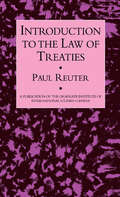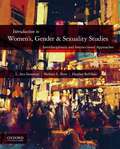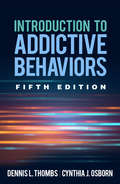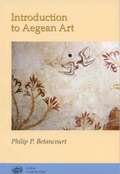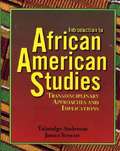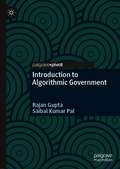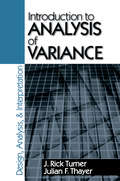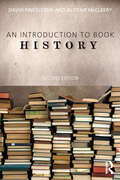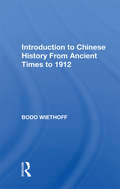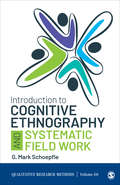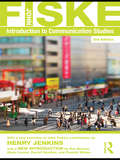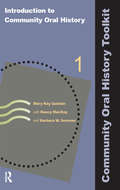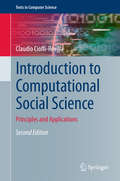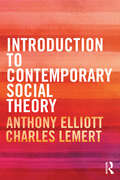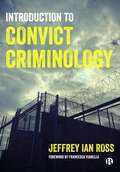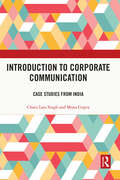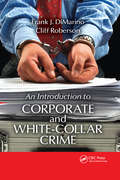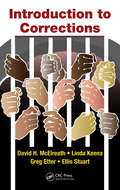- Table View
- List View
Introduction To The Law Of Treat
by ReuterFirst Published in 1995. Routledge is an imprint of Taylor & Francis, an informa company.
Introduction To Women's, Gender, And Sexuality Studies: Interdisciplinary and Intersectional Approaches
by L. Ayu Saraswati Barbara Shaw Heather RellihanWomen's and Gender Studies departments and programs are undergoing rapid transformation, creating the need for a comprehensive and accessible introductory textbook that addresses the current state of the field. Introduction to Women's, Gender, and Sexuality Studies: Interdisciplinary and Intersectional Approaches is the first text to reflect the exciting changes taking place in this field. Emphasizing both interdisciplinarity and intersectionality, this innovative mix of anthology and textbook includes key primary historical sources, debates on contemporary issues, and recent work in science, technology, and digital cultures. Readings from a range of genres-including poetry, short stories, op-eds, and feminist magazine articles-complement the scholarly selections and acknowledge the roots of creative and personal expression in the field. While the majority of selections are foundational texts, the book also integrates new work from established scholars and emerging voices to expand current debates in the field. The text is enhanced by thorough overviews that begin each section, robust and engaging pedagogy that encourages students to think critically and self-reflexively-and also to take action-as well as supplemental online resources for instructors.
Introduction to Action Research: Social Research for Social Change
by Morten Levin Davydd James GreenwoodThe Second Edition of Introduction to Action Research: Social Research for Social Change makes social science matter! It focuses on how it is possible to combine practical problem solving with generating new theoretical insights. Authors Davydd J. Greenwood and Morten Levin combine a thorough discussion of the epistemological foundations of action research with a broad overview of major contemporary trends in the field. New to the Second Edition: Includes a vast amount of updated information: Nine chapters have been significantly updated, including two new chapters that engage readers into the current debates on action research as "tradition" or its own "methodology," and how action research takes shape in the university environment. New textboxes highlight important issues in each chapter and more detailed cases and real-world examples illustrate the practical implications of AR in a variety of settings. Incorporates a new structure: New information pertains specifically to issues of techniques, work forms, and research strategies based on the authors’ experiences in using the book in teaching. The book now has 4 parts instead of 3, with an entirely new section on higher education and democracy as a concluding section. Emphasizes the skill sets needed to do action research: This book deals with the process of educating action researchers and reviews a number of programs that do this. Specific attention is given to the challenges of writing and intellectual property in AR, and more focus is devoted to both adult and formal education, creating a comprehensive overview of the field that is not found in any other action research book. Intended Audience: This is an excellent textbook for advanced undergraduate and graduate courses in Action Research, Social Research, and Qualitative Research across the social sciences.
Introduction to Addictive Behaviors (4th Edition)
by Dennis L. Thombs Cynthia J. OsbornThis widely adopted text introduces students and practitioners to major contemporary models of addiction. Assuming no prior knowledge in the field, the book shows how theory and research can offer a roadmap for effective intervention. It presents multiple perspectives on the causes and mechanisms of substance use problems, reviews their strengths and limitations, and examines their implications for helping people change their behavior. Evidence-based treatment and prevention strategies are described.Pedagogical Features Include:*Accessible style and clear organization.*Concise end-of-chapter summaries.*Review questions in every chapter.New to This Edition*The latest research on prevention and treatment, including current data and revised discussions of genetic influences, family treatment models, and many other topics.*Updated for DSM-5.*Chapter on behavioral addictions.*Chapter on promoting motivation and autonomy.*Chapter on evidence-based practice.
Introduction to Addictive Behaviors, Fifth Edition
by Dennis L. Thombs Cynthia J. OsbornNow revised and updated, this widely used text comprehensively reviews theories of addiction to give students and professionals a multidisciplinary foundation for clinical practice. It explores the causes and mechanisms of substance and behavioral addictions, as well as implications for helping people recover. Providing a science-based perspective, the text emphasizes the importance of using treatment and prevention strategies that are grounded in evidence. Thoroughly updated chapters address disease models; public health approaches; understanding and treating comorbidity; psychoanalytic, behavioral, cognitive, and family systems models; sociocultural approaches; behavioral addiction; and motivational models. Student-friendly features include end-of-chapter summaries and review questions. New to This Edition *Updated throughout with current research and clinical advances. *Discussions of cutting-edge topics: genetics of addiction, addiction stigma, and the opioid epidemic. *New and revised clinical vignettes and review questions.
Introduction to Aegean Art
by Philip P. BetancourtThis textbook is a compilation of the author's more than 35 years of teaching and excavation experience in the field of Aegean Bronze Age art history and archaeology. It is geared toward an audience of undergraduate and graduate students as an introduction to the Bronze Age art objects and architecture that have been uncovered on Crete, the Greek peninsula, and the Cycladic Islands.
Introduction to African American Studies: Transdisciplinary Approaches and Implications
by James Stewart Talmadge AndersonThere is an ongoing debate as to whether African American Studies is a discipline, or multidisciplinary or interdisciplinary field. Some scholars assert that African American Studies use a well-defined common approach in examining history, politics, and the family in the same way as scholars in the disciplines of economics, sociology, and political science. Other scholars consider African American Studies multidisciplinary, a field somewhat comparable to the field of education in which scholars employ a variety of disciplinary lenses-be they anthropological, psychological, historical, etc., --to study the African world experience. In this model the boundaries between traditional disciplines are accepted, and researches in African American Studies simply conduct discipline based an analysis of particular topics. Finally, another group of scholars insists that African American Studies is interdisciplinary, an enterprise that generates distinctive analyses by combining perspectives from different traditional disciplines and synthesizing them into a unique framework of analysis.
Introduction to Algorithmic Government
by Rajan Gupta Saibal Kumar PalThe world is changing at a fast pace, so is the Government and Governance style. Humans are bound to go for Algorithmic strategies rather than manual or electronic ones in different domains. This book introduces the Algorithmic Government or Government by Algorithm, which refers to authorizing machines in the Public Sector for automated decision-making based on Artificial Intelligence, Data Science, and other technologies. It is an emerging concept introduced globally and will be considered revolutionary in the future. The book covers concepts, applications, progress status, and potential use-cases of Algorithmic Government. This book serves as introductory material for the readers from technology, public policy, administration, and management fields.
Introduction to Analysis of Variance: Design, Analyis & Interpretation
by J Turner Dr Julian F. ThayerOrganized so that the reader moves from the simplest type of design to more complex ones, the authors introduce five different kinds of ANOVA techniques and explain which design//analysis is appropriate to answer specific questions.
Introduction to Book History
by David Finkelstein Alistair McCleeryThis second edition of An Introduction to Book History provides a comprehensive critical introduction to the development of the book and print culture. Each fully revised and updated chapter contains new material and covers recent developments in the field, including: The Postcolonial Book Censorship by states and religions Social History, and the recognition of underrepresentation of its value to book history studies Contemporary publishing Each section begins with a summary of the chapter’s aims and contents, followed by a detailed discussion of the relevant issues, concluding with a summary of the chapter and points to ponder. Sections include: the history of the book orality to Literacy literacy to printing authors, authorship and authority printers, booksellers, publishers, agents readers and reading the future of the book. An Introduction to Book History is an ideal introduction to this exciting field of study, and is designed as a companion text to The Book History Reader.
Introduction to Chinese Culture: Cultural History, Arts, Festivals And Rituals
by Guobin Xu Yanhui Chen Lianhua XuPromoting cultural understanding in a globalized world, this text is a key tool for students interested in understanding the fundamentals of Chinese culture. Written by a team of experts in their fields, it offers a comprehensive and detailed introduction to Chinese culture and addresses the fundamentals of Chinese cultural and social development. It notably considers Chinese traditional culture, medicine, arts and crafts, folk customs, rituals and etiquette, and is a key read for scholars and students in Chinese Culture, History and Language.
Introduction to Chinese History From Ancient Times to 1912
by Bodo WiethoffConfining itself to the ancient and traditional state which ended constitutionally in 1912, this book aims to provide an introduction to the history of China. In dealing with Chinese history since the abdication in that year of the last Ch'ing emperor, a completely separate approach seems necessary, in view of that history's complexity, terms of reference, and what is perhaps a quite different structure -though admittedly the origins of the modem state may be sought in the traditional era and past traditions can be regarded as surviving for a time.
Introduction to Cognitive Cultural Studies
by Lisa ZunshineDrawing on the explosion of academic and public interest in cognitive science in the past two decades, this volume features articles that combine literary and cultural analysis with insights from neuroscience, cognitive evolutionary psychology and anthropology, and cognitive linguistics. Lisa Zunshine’s introduction provides a broad overview of the field. The essays that follow are organized into four parts that explore developments in literary universals, cognitive historicism, cognitive narratology, and cognitive approaches in dialogue with other theoretical approaches, such as postcolonial studies, ecocriticism, aesthetics, and poststructuralism. Introduction to Cognitive Cultural Studies provides readers with grounding in several major areas of cognitive science, applies insights from cognitive science to cultural representations, and recognizes the cognitive approach’s commitment to seeking common ground with existing literary-theoretical paradigms. This book is ideal for graduate courses and seminars devoted to cognitive approaches to cultural studies and literary criticism.Contributors: Mary Thomas Crane, Nancy Easterlin, David Herman, Patrick Colm Hogan, Bruce McConachie, Alan Palmer, Alan Richardson, Ellen Spolsky, G. Gabrielle Starr, Blakey Vermeule, Lisa Zunshine
Introduction to Cognitive Ethnography and Systematic Field Work (Qualitative Research Methods)
by G. Mark SchoepfleIntroduction to Cognitive Ethnography and Systematic Field Work by G. Mark Schoepfle provides a guide to the fundamentals of cognitive ethnography for qualitative research. A focus of this technique is collecting data from flexible but rigorous interviews. These interviews are flexible because they are designed to be structured around the semantic knowledge being elicited from the speaker, not around some pre-conceived design that is based on the researcher’s background, and they are rigorous because the basic linguistic and semantic structures are shared among all cultures. Written by one of the founders of this technique, this text provides a wealth of concentrated knowledge developed over years to best suit this collaborative and participant-centric research process. Eight chapters show how intertwined data collection and analysis are in this method. The first chapter offers a brief history and overview of the cognitive ethnography. Chapter 2 covers planning a research project, from developing a research question to ethics and IRB requirements. The next two chapters cover interview background, techniques, and structures. Chapter 5 addresses analysis while Chapter 6 covers transcription and translation. Chapter 7 covers observation, while a final chapter address writing a report for both consultants and outside audiences.
Introduction to Cognitive Ethnography and Systematic Field Work (Qualitative Research Methods)
by G. Mark SchoepfleIntroduction to Cognitive Ethnography and Systematic Field Work by G. Mark Schoepfle provides a guide to the fundamentals of cognitive ethnography for qualitative research. A focus of this technique is collecting data from flexible but rigorous interviews. These interviews are flexible because they are designed to be structured around the semantic knowledge being elicited from the speaker, not around some pre-conceived design that is based on the researcher’s background, and they are rigorous because the basic linguistic and semantic structures are shared among all cultures. Written by one of the founders of this technique, this text provides a wealth of concentrated knowledge developed over years to best suit this collaborative and participant-centric research process. Eight chapters show how intertwined data collection and analysis are in this method. The first chapter offers a brief history and overview of the cognitive ethnography. Chapter 2 covers planning a research project, from developing a research question to ethics and IRB requirements. The next two chapters cover interview background, techniques, and structures. Chapter 5 addresses analysis while Chapter 6 covers transcription and translation. Chapter 7 covers observation, while a final chapter address writing a report for both consultants and outside audiences.
Introduction to Communication Studies
by John FiskeThis revised edition of a now classic text includes a new introduction by Henry Jenkins, explaining ‘Why Fiske Still Matters’ for today’s students, followed by a discussion between former Fiske students Ron Becker, Elana Levine, Darrell Newton and Pamela Wilson on the theme of ‘Structuralism and Semiotics, Fiske-Style’. Both underline the continuing relevance of this foundational text in communication studies. How can we study communication? What are the main theories and methods of approach? This classic text provides a lucid, accessible introduction to the main authorities in the field of communication studies, aimed at students coming to the subject for the first time. It outlines a range of methods of analysing examples of communication, and describes the theories underpinning them. Thus armed, the reader will be able to tease out the latent cultural meanings in such apparently simple communications as news photos or popular TV programmes, and to see them with new eyes.
Introduction to Community Oral History (Community Oral History Toolkit #1)
by Nancy MacKay Barbara W Sommer Mary Kay QuinlanThe first book of the five-volume Community Oral History Toolkit sets the stage for an oral history project by placing community projects into a larger context of related fields and laying a sound theoretical foundation. It introduces the field of oral history to newcomers, with discussions of the historical process, the evolution of oral history as a research methodology, the nature of community, and the nature of memory. It also elaborates on best practices for community history projects and presents a detailed overview of the remaining volumes of the Toolkit, which cover Planning, Management, Interviewing, and After-the-Interview processing and curation. Introduction to Community Oral History features a comprehensive glossary, index, bibliography, and references, as well as numerous sample forms that are needed throughout the process of conducting community oral history projects.
Introduction to Computational Cultural Psychology
by Yair NeumanHuman psychology is deeply rooted in the culture in which people live. Introduction to Computational Cultural Psychology introduces a revolutionary approach for studying cultural psychology. Drawing on novel computational tools and in-depth case studies, Professor Yair Neuman offers thought-provoking answers to questions such as: how are thought and language deeply related? How can computers help us to understand different cultures? How can computers assist military intelligence in identifying vengeful intentions? And how is our concept of 'love' rooted in our basic embodied experience? Written by a leading interdisciplinary researcher this book is a "tour-de-force" which will be of interest to a variety of researchers, students and practitioners in psychology as well as an interdisciplinary audience with an interest in the intricate web weaved between the human psyche and its cultural context.
Introduction to Computational Social Science
by Claudio Cioffi-RevillaThis reader-friendly textbook is the first work of its kind to provide a unified Introduction to Computational Social Science (CSS). Four distinct methodological approaches are examined in detail, namely automated social information extraction, social network analysis, social complexity theory and social simulation modeling. The coverage of these approaches is supported by a discussion of the historical context, as well as by a list of texts for further reading. Features: highlights the main theories of the CSS paradigm as causal explanatory frameworks that shed new light on the nature of human and social dynamics; explains how to distinguish and analyze the different levels of analysis of social complexity using computational approaches; discusses a number of methodological tools; presents the main classes of entities, objects and relations common to the computational analysis of social complexity; examines the interdisciplinary integration of knowledge in the context of social phenomena.
Introduction to Computational Social Science
by Claudio Cioffi-RevillaThis reader-friendly textbook is the first work of its kind to provide a unified Introduction to Computational Social Science (CSS). Four distinct methodological approaches are examined in detail, namely automated social information extraction, social network analysis, social complexity theory and social simulation modeling. The coverage of these approaches is supported by a discussion of the historical context, as well as by a list of texts for further reading. Features: highlights the main theories of the CSS paradigm as causal explanatory frameworks that shed new light on the nature of human and social dynamics; explains how to distinguish and analyze the different levels of analysis of social complexity using computational approaches; discusses a number of methodological tools; presents the main classes of entities, objects and relations common to the computational analysis of social complexity; examines the interdisciplinary integration of knowledge in the context of social phenomena.
Introduction to Contemporary Social Theory
by Charles Lemert Anthony ElliottIn this comprehensive, stylish and accessible introduction to contemporary social theory, Anthony Elliott and Charles Lemert examine the major theoretical traditions from the Frankfurt School to globalization and beyond. When first published, the book’s wide range set new standards for introductory textbooks – social theorists discussed include Theodor Adorno, Herbert Marcuse, Michel Foucault, Jacques Lacan, Jacques Derrida, Anthony Giddens, Pierre Bourdieu, Julia Kristeva, Jurgen Habermas, Judith Butler, Slavoj Zizek, Manuel Castells, Ulrich Beck, Zygmunt Bauman, Giorgio Agamben and Manuel De Landa. Extensively developed to take into account significant recent developments in American social theory, the book offers chapters on American pragmatism, structural functionalism, ethnomethodology, black feminist thought and world-systems theory. American traditions of social theory are brought powerfully to life in treatments of intellectuals ranging from William James to Robert K. Merton, David Riesman to Randall Collins, and Patricia Hill Collins to Saskia Sassen. Introduction to Contemporary Social Theory combines lively exposition and clarity with reflective social critique and original insights, and is a superb textbook with which to navigate the twists and turns of contemporary social theory as taught in the disciplines of sociology, politics, history, cultural studies and many more.
Introduction to Convict Criminology
by Jeffrey Ian RossConvict criminology (CC) is based on the belief that the convict’s voice has been traditionally ignored or marginalized in scholarship and policy debates, and that its inclusion can positively impact the fields of corrections, criminology, criminal justice, and policy making. Designed for students, scholars, and activists worldwide this is the first sole-authored book to comprehensively explain the CC approach to scholarship, teaching, mentorship, and prison and criminal justice activism. It reviews the history and scholarship on this engaging field and the challenges that the approach has encountered. It features: • exhibit boxes • keywords • test questions - including multiple choice, short answer and essay format.
Introduction to Corporate Communication: Case Studies from India
by Charu Lata Singh Mona GuptaThis book examines the evolution of corporate communication in the recent past in the context of the rapidly changing contemporary business environment in India. Using several case studies, it illustrates the growing need for small and large businesses to recognize and form a direct connection with their stakeholders and further explains the effective ways through which specific business requirements are realized by communication managers. The book explores the greater dependency and function of multiple media strategies and their challenges. It also offers various theoretical and practical insights into the successful integration of diverse communication and marketing strategies like employee communication, investor relations, corporate social responsibility and philanthropy, branding, crisis management, and corporate ethics and governance, among others. Lucid and comprehensive, this book will be an essential read for students and scholars of corporate communications, business management, media and communication studies, public relations, and marketing, as well as communication and marketing practitioners.
Introduction to Corporate and White-Collar Crime
by Cliff Roberson Frank J. DiMarinoWhite-collar crime costs the United States more than $300 billion each year. It is surprisingly common, with one in every three Americans eventually becoming a victim. The criminals often dismiss these crimes as victimless, but those unfortunate enough to fall prey would disagree. An Introduction to Corporate and White-Collar Crime provides readers
Introduction to Corrections
by David H. McElreath Greg Etter Linda Keena Ellis Stuart Jr.Millions in our nation are under some type of judicial sanction, with some individuals behind bars but the majority serving their sentences while living and working among us. Introduction to Corrections examines predominant issues related to the system of administering to offenders in the United States. Written in a simple, concise style and enhanc
